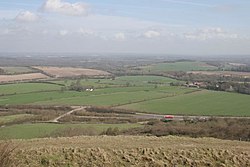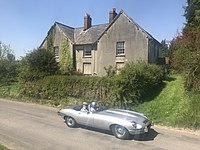Old Burghclere
| Old Burghclere | |
| Hampshire | |
|---|---|
 Old Burghclere from Beacon Hill | |
| Location | |
| Grid reference: | SU468576 |
| Location: | 51°18’58"N, 1°19’45"W |
| Data | |
| Post town: | Newbury |
| Postcode: | RG20 |
| Dialling code: | 01635 |
| Local Government | |
| Council: | Basingstoke and Deane |
| Parliamentary constituency: |
North West Hampshire |
Old Burghclere is the original village of the Parish of Burghclere, today's Burghclere village being two and a half miles to the north. The villages are in the north of Hampshire, south of the Berkshire border and the latter county's major town, Newbury.
This village is near the A34 road, a relentless dual carriageway trunk road ploughimng its way from north to south: the old road it supplanted ran through Burghclere and past Old Burghclere, while the modern road was created as part of the scheme that created the Newbury bypass.
Burghclere has been known variously as: Clere Episcopi, Burcler (xiii cent.); Bisshopesclere, Bourghclere, Burghclere (xiv cent.); Boroughclere, Burghcleere, Boroweclere, Burcleare (xvi cent.); Burroughclere, Borough Cleere, and Burgh Cleere (xvii cent.).[1]
In the heart of Old Burghclere, in centre of the whole Burghclere parish stands the old church of All Saints, and close by is Burghclere Manor House, which was formerly the rectory. Burghclere Farm is north of the old church. The modern church of The Ascension stands on a hill in the north of the parish, away from Old Burghclere.
In 1233 the common fields (campi) of Burghclere comprised Stock (67½ acres), Surlande (31½ acres), Harebert and Leylie (242 acres), Lendecumbe (151 acres), as well as 10 acres of meadow dispersed over the manor. These commons were inclosed in 1783.[1]
The southern part of the parish, Old Burghclere, is open down country. Beacon Hill (842 feet) is here a conspicuous landmark, upon which are the remains of an ancient earthwork.
Down Farm lay east of the hill close to the former Didcot, Newbury and Southampton Railway run by the Great Western Railway, which ran almost due north from here through the parish.
Owners
Burghclere remained in the possession of the Diocese of Winchester until 1551. The most notable Bishops of Winchester being William of Wykeham (1320 or 1324–1404), who founded New College, Oxford, and New College School in 1379, and Winchester College in 1382, but also owned, in his own right, Earlstone manor in the parish of Burghclere. William Waynflete, Lord Chancellor of England (1456–1460) and founder of Magdalen School and College in Oxford was also particularly renowned.
In 1551 Edward VI received the manor from John Ponet, Bishop of Winchester, in exchange for lands elsewhere.[1] The king then granted it to William FitzWilliam in the same year. Sir William at his death divided the manor between his three younger daughters, through whose various lines lands descended.
Parish church
The Church of All Saints, Old Burghclere, c.1100 (grade 1 listed, 1966). During its 1861 restoration a painting of the Martyrdom of Saint Sebastian was found over the chancel arch, but was not reinstated;[2]
About the village
- Former rectory house, now The Manor House, Old Burghclere. The central hall range has timber with felling dates of Winter 1328/9. In 1861 the Rector was resident, George Wallace;
- Manor Barn, Old Burghclere is an 8-bay, aisled threshing barn with two porches (grade 1 listed, 1984). Documentary sources record payment to a carpenter to build a barn of eight bays and two porches at Old Burghclere in 1451/52-1453, during the time of the bishop of Winchester William Waynflete. It is similar to the great barn at Harmondsworth, which is 25 years earlier and four bays longer. Both are associated with Winchester and William of Wykeham (1320 or 1324 – 27 September 1404). Harmondsworth was part of Winchester College and New College, Oxford's Wykehamist endowment;
- Manor Farm. The tenant farmer in 1851 was John Cozens, with 1,100 acres, and 24 labourers. In 1861 the farmer was Samuel Wentworth, 51, and 18 were housed, listed as farmer of 1,350 acres employing 40 mean and 10 boys.[3] Sam Wentworth, 32, younger, was there in 1871 1,336 acres, 27 labourers and nine boys, housing 11, and in 1881 the younger Sam Wentworth was still listed as the farmer of 1,380 acres employing 29 men and boys.[4] He was still there aged 72 with his wife in 1911.
- Concrete Cottages (1870), in the former Long Piddle, Burghclere Bottom, Scouses Corner, on the north side of the Kingsclere and Sydmonton road. Rare and pioneering (because such use of concrete was only patented in 1864-1868). They were put up using Tall's patent shuttering, Tall's Concrete Moulding Machine or General Builder, aka Joseph Tall's Patent Concrete Machine, of Falstaff Yard, Kent street, Southwark.[5] A concrete dwelling built for the magnificent Henry Herbert, 4th Earl of Carnarvon. Tripartite they show both agricultural and urban Neo-Palladian traits. Drake used designs by Charles Barry Junior (1823-1900) or Thomas Robjohns Wonnacott (1834-1918), RIBA, of Farnham but here the explicit designer is unclear. The Reading Mercury, Saturday, 30 October 1869, reported the building:
'BURGHCLERE - Considerable amount of interest has been excited in this locality on the subject of Cheap Dwellings for the Working Classes, owing to a report that the Earl of Carnarvon was about to start the new system of building houses in concrete. His Lordship has already commenced the erection of a block of three cottages at Burghclere Bottom, and no doubt the result will be anticipated with much interest both by landed proprietors and tenant farmers. This plan, if successful, will settle much controversy as to the predictability of building suitable farm cottages at a cheap rate, as up to this time cottages in brickwork do not afford interest on the capital expended. The work is to be done with Tall's Patent Concrete Machine, and is not expected to cost more than 6L. [£6] per rod standard thickness [a rod is 5 meters, or 5.5 yard, 16.5 feet]. Many buildings of various descriptions have already been erected on this principle throughout the country, and competent judges have pronounced them the exact kind of building that is wanted. They are said to have a neat appearance when completed, and are not only stronger and more durable than brickwork, but warmer and consequently more dry and healthy.' Reading Mercury, Saturday, 30 October 1869
At the time of the 1871 census seven adults and five children were living in the terrace that was the Concrete Cottages.
A railway station opened in 1885 by the Didcot, Newbury and Southampton Railway: originally it was named Sydmonton, subsequently Burghclere Station. While further from the village of Burghclere than Highclere railway station it was relatively busy, serving the larger village of Kingsclere. Closed in 1963, now a private residence.[6]
Outside links
| ("Wikimedia Commons" has material about Old Burghclere) |
References
- ↑ 1.0 1.1 1.2 @A History of the County of Hampshire - Volume 4 pp 277-281: Parishes: Burghclere (Victoria County History)
- ↑ VCH, 1911
- ↑ 1861, UK Census.
- ↑ 1881, UK Census.
- ↑ Compare with the activities of Charles Drake, of Drake Brothers & Reid, Concrete Machinists & Builders, 208 New Kent Road, London, who had worked as a manager for Joseph Tall. Charles Drake's Building Apparatus, had been patented in 1868 by The Drake Patent Concrete Building Company.
- ↑ Time Capsules - Old Photographs from the past (2009-02-26). "Old Photographs from the past - Burghclere Railway Station". Time Capsules. http://www.time-capsules.co.uk/picture/number872.asp. Retrieved 2013-02-21.
- Canning, Briony Susan: 'The Story of Burghclere' (1998)
- Timmins, Gordon: 'Burghclere'



